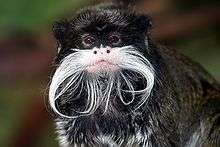Tamarin
| Tamarins[1][2] | |
|---|---|
 | |
| Emperor tamarin, a New World monkey | |
| Scientific classification | |
| Kingdom: | Animalia |
| Phylum: | Chordata |
| Class: | Mammalia |
| Order: | Primates |
| Family: | Callitrichidae |
| Genus: | Saguinus Hoffmannsegg, 1807 |
| Type species | |
| Saguinas ursula Hoffmannsegg, 1807 | |
| Species | |
|
18 species, see text | |
| Synonyms | |
| |
The tamarins are squirrel-sized New World monkeys from the family Callitrichidae in the genus Saguinus. They are closely related to the lion tamarins in the genus Leontopithecus.
Description
Different tamarin species vary considerably in appearance, ranging from nearly all black through mixtures of black, brown and white. Mustache-like facial hairs are typical for many species. Their body size ranges from 13 to 30 cm (plus a 25 to 44 cm long tail) and they weigh from 220 to 900 grams. Tamarins differ from marmosets primarily in having lower canine teeth that are clearly longer than the incisors. In captivity, tamarins can live for up to 18 years.
Distribution
Tamarins range from southern Central America through central South America, where they are found in northwestern Colombia, the Amazon basin, and the Guianas.
Behavior and reproduction
Tamarins are inhabitants of tropical rainforests and open forest areas. They are diurnal and arboreal, and run and jump quickly through the trees. Tamarins live together in groups of up to 40 members consisting of one or more families. More frequently, though, groups are composed of just three to nine members.
Tamarins are omnivores, eating fruits and other plant parts as well as spiders, insects, small vertebrates and bird eggs.
Gestation is typically 140 days, and births are normally twins. The adult males, subadults, and juveniles in the group assist with caring for the young, bringing them to their mother to nurse. After approximately one month the young begin to eat solid food, although they aren't fully weaned for another two to three months. They reach full maturity in their second year. Tamarins are almost exclusively polyandrous.
Predators
While tamarins spend much of their day foraging, they must be on high alert for aerial and terrestrial predators. Due to their small size compared to other primates, they are an easy target for predatory birds, snakes, and mammals.[3]
Taxonomy
The first classification of Saguinus tamarins contained ten different species, further divided into 33 morphotypes based on facial pelage.[4] A later classification into two clades was based on variations in dental measurements.[5] The latest classification postulates fifteen species with no subspecies.[6]
Classification
- Genus Saguinus
- S. midas group
- Red-handed tamarin, Saguinus midas
- Saguinus ursula [7]
- Black tamarin, Saguinus niger
- S. nigricollis group
- Black-mantled tamarin, Saguinus nigricollis
- Spix's black-mantled tamarin, Saguinus nigricollis nigricollis
- Hernandez-Camacho's black-mantled tamarin Saguinus nigricollis hernandezi
- Graells's tamarin, Saguinus graellsi
- Brown-mantled tamarin or saddle-back tamarin, Saguinus fuscicollis
- Spix's saddle-back tamarin, Saguinus fuscicollis fuscicollis
- Geoffroy's saddle-back tamarin, Saguinus fuscicollis nigrifrons
- Illiger's saddle-back tamarin, Saguinus fuscicollis illigeri
- Andean saddle-back tamarin, Saguinus fuscicollis leucogenys
- Red-mantle saddle-back tamarin, Saguinus fuscicollis lagonotus
- Saguinus fuscicollis fuscus
- Avila Pires' saddle-back tamarin, Saguinus fuscicollis avilapiresi
- Weddell's saddle-back tamarin, Saguinus fuscicollis weddelli
- Cruz Lima's saddle-back tamarin, Saguinus fuscicollis cruzlimai
- Saddle-back tamarin, Saguinus fuscicollis primitivus
- Mura's saddle-back tamarin, Saguinus fuscicollis mura
- White-mantled tamarin, Saguinus melanoleucus
- Golden-mantled tamarin, Saguinus tripartitus
- Black-mantled tamarin, Saguinus nigricollis
- S. mystax group
- Moustached tamarin, Saguinus mystax
- Spix's moustached tamarin, Saguinus mystax mystax
- White-rump moustached tamarin, Saguinus mystax pluto
- Red-capped tamarin, Saguinus pileatus
- White-lipped tamarin, Saguinus labiatus
- Emperor tamarin, Saguinus imperator
- Moustached tamarin, Saguinus mystax
- S. bicolor group
- Pied tamarin, Saguinus bicolor
- Martins's tamarin, Saguinus martinsi
- Martin's bare-face tamarin, Saguinus martinsi martinsi
- Ochraceus bare-face tamarin, Saguinus martinsi ochraceus
- S. oedipus group
- Cotton-top tamarin or Pinché tamarin, Saguinus oedipus
- Geoffroy's tamarin, Saguinus geoffroyi
- White-footed tamarin, Saguinus leucopus
- S. inustus group
- Mottle-faced tamarin, Saguinus inustus
- S. midas group
References[3]
- ↑ Groves, C.P. (2005). Wilson, D.E.; Reeder, D.M., eds. Mammal Species of the World: A Taxonomic and Geographic Reference (3rd ed.). Baltimore: Johns Hopkins University Press. pp. 133–136. OCLC 62265494. ISBN 0-801-88221-4.
- ↑ Rylands AB, Mittermeier RA (2009). "The Diversity of the New World Primates (Platyrrhini): An Annotated Taxonomy". In Garber PA, Estrada A, Bicca-Marques JC, Heymann EW, Strier KB. South American Primates: Comparative Perspectives in the Study of Behavior, Ecology, and Conservation. Springer. pp. 21–54. ISBN 978-0-387-78704-6.
- 1 2 Miller, Lynne (2002). Eat or be Eaten. Cambridge University Press. ISBN 0-521-01104-3.
- ↑ Hershkovitz, Philip (1977). Living New World Monkeys (Platyrrhini) : With an Introduction to Primates (1st ed.). University of Chicago Press. ISBN 9780226327884.
- ↑ Natori, M.; Hanihara, T. (1992). "Variations in dental measurements between Saguinus species and their systematic relationships". Folia Primatologica. 58 (2): 84–92.
- ↑ Ferrari, Stephen; Silva, Suleima. "Notes on the reproduction, behaviour and diet of Sanguinus niger (Primates: Callitrichidae) in a forest remnant at the National Primate Centre, Ananindeua, Pará". Retrieved 2016-07-12.
- ↑ Gregorin, R.; De Vivo, M. 2013: Revalidation of Saguinus ursula Hoffmannsegg (Primates: Cebidae: Callitrichinae). Zootaxa, 3721(2): 172-182. doi:10.11646/zootaxa.3721.2.4
External links
| Wikispecies has information related to: Tamarin |